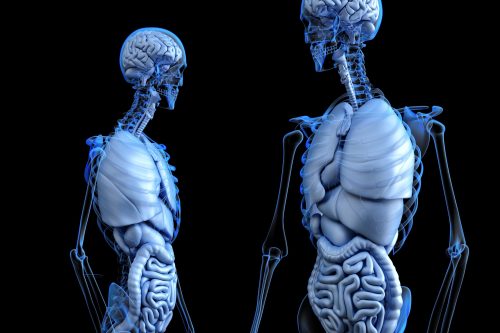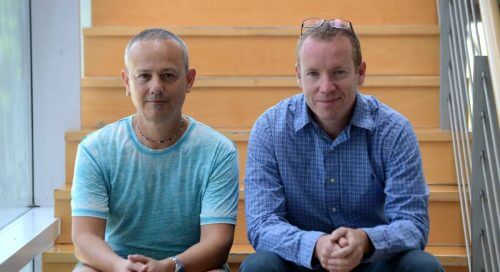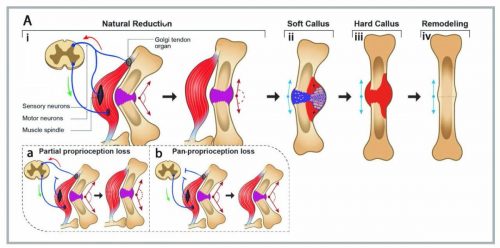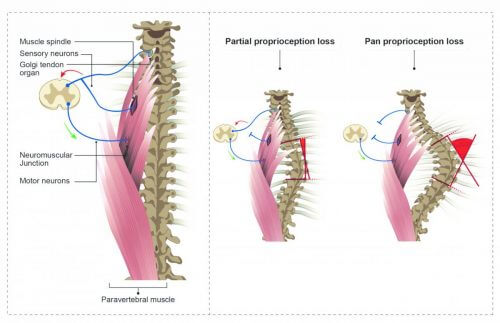Weizmann Institute scientists have shown that mechanical sensory receptors found in the muscles (the proprioception system) maintain the function and structure of the skeletal system and help in the fusion of fractures

How do bones reach their destination - that is, do they "know", in the process of growth, to what extent they should lengthen and strengthen? Think about the following situation: you have found yourself in a foreign city, and you are looking for an address. To get to your destination, you can use a map, ask a passerby for directions, or use a navigation app like Waze to guide you on your journey. If you're lucky, you might come across a local traveling in the same direction, and you can relax in your seat and let him lead you safely to your destination. But do bone cells also navigate using a detailed genetic map, or according to navigation instructions from the hormonal system? And maybe they even "allow" another driver to lead them according to the twists and turns of the road without a pre-prepared plan? Two new studies by Weizmann Institute of Science scientists shed light on the significant role of muscles in directing the skeletal system, maintaining its structure, and bringing it to its goals safely.
Now close your eyes and try to touch your nose with your index finger. Most of us are able to perform this movement with great precision, but how do we know how to locate the nose in space without the sense of sight? And how do we manage to track the position of the arm while moving? The sense of our position in space is called proprioception (from the Latin word proprius - "belongs to me") and some also call it the "sixth sense". Unlike the other five senses, the sixth sense is not directed outward, but only inward. It is a self-sensing of the position of our body parts and their movement. The muscles are a central agent of the sixth sense through two mechanical sensory receptors: the muscle spindle - an organ found in the muscles and responds to changes in their length, and the Golgi tendon organ - located in the area of the connection between the muscles and tendons, and responds to the degree of contraction of the muscles. But how does the stretch and length of the muscle affect the skeletal system and steer it?
In every textbook it will be written that the muscles are responsible for the movement, and the skeleton is responsible for the structure. But here there is a reversal of roles, and the muscle is actually responsible for the structure of the bone. It breaks conventions"

A few years ago, scientists in the laboratory of Prof. Elazar Seltzer, from the department of molecular genetics at the institute, because broken bones "know" how to straighten quickly, even without medical intervention and immobilization with plaster. The research was led by Dr. Ronan Belcher, an orthopedist in the spinal surgery unit at the Assaf Harofeh Medical Center, who joined doctoral studies at the institute as part of a collaboration between the hospital and Prof. Seltzer's laboratory. This finding was surprising, since the common assumption was that broken bones connect at an angle, and only then are reshaped in a process called "remodeling of the bone": a new bone grows and replaces the old bone. The researchers realized even then that the bone's ability to straighten itself is related to the muscle activity: after they injected botox into the mice and paralyzed their muscles, the broken bones did realign, but at an angle. In the present study, QRecently published in the scientific journal Cell reports, The researchers showed that in genetically modified mice in which one of the genes responsible for the activity of the sensory receptors in the muscles - Runx3 or Egr3 - had been neutralized, the broken bones did not straighten. These findings reveal the role of the "sixth sense" in the functioning of the skeletal system and in the successful fusion of fractures.
So far, the findings corresponded to the research hypotheses. However, in mice without sensory receptors in the muscles, an unforeseen problem was discovered. Thanks to Dr. Belcher's medical perspective, and his ability to decipher X-rays, the researchers noticed that the mice developed a problem similar to juvenile scoliosis: their spines curved without a known cause or abnormalities in the skeleton, as happens in most cases of scoliosis in humans. These findings, Qwere published recentlyin the scientific journal Developmental Cell, indicate for the first time that proprioception is also involved in maintaining the correct position of the spine. This approach constitutes a significant innovation in the treatment of scoliosis, which for a long time was considered a disease of bones. As part of this study, the researchers collaborated with the laboratory of Prof. Yoram Groner, which has been researching the Runx gene family for years, and its effect on the proprioceptive system.

"In every textbook it will be written that the muscles are responsible for the movement, and the skeleton is responsible for the structure. But here there is a reversal of roles, and the muscle is actually responsible for the structure of the bone. It breaks conventions", explains Prof. Seltzer of the importance of research. "The meaning is that a large part of the information necessary to create the skeleton, and to maintain it, is not found in the skeleton itself, but in interaction with other tissues. If there is a muscle attached to the skeleton and it pulls, by virtue of being a muscle, the bone reacts and produces a structure that is suitable to stand in front of the muscle. If the bone knows how to 'listen' to the muscle, then as soon as the muscle exerts force on it, it will know how to behave. I don't know how much of it is genetically coded and how much is mechanically controlled, but the mechanical side has a very big influence."
Besides the importance of proprioception in the proper functioning of the skeleton, another message that may be sharpened following Prof. Seltzer's research is the importance of holistic and interdisciplinary thinking. Just as the answers to questions about the skeletal system are not necessarily found in the skeleton itself, so the keys to successful research are not necessarily exclusively found in the scientists. Says Prof. Seltzer: "I am a developmental biologist, and I understand very well how the skeleton is formed, but I have no understanding of the diseases and pathologies that doctors see in hospitals. And not only that - doctors have a different point of view. Researchers are used to focusing on specific questions and working in an orderly manner: some people study the skeleton, some people study muscles, some people study tendons, and so on. But there are far fewer people who study the system - and it is also much more complicated. With doctors, on the other hand, the view is usually much broader."

#Science_Numbers
Spinal scoliosis is most often discovered in adolescence without a known cause and its prevalence in the population is about 3%. The incidence of severe scoliosis cases (angle of more than 40 degrees) among women is much higher than among men.

5 תגובות
Thanks for the research, very exciting findings. My question is: when a bone is broken, it is customary to put it in a cast, which prevents the activation of the associated muscles and, as a side effect, also the muscle skills and GTOs. Even though it sounds like the obvious solution (plaster), I wonder if it might eventually "damage" the adequate fusion as a result from the mechanistic point of view of the body? Or, alternatively, does the use of a cast actually make redundant the role of these mechanoreceptors in this context?
Container
It's already more serious 🙂 I didn't see that he was talking about a revolution, but about the expansion of existing things - but I don't understand in this area, and maybe you're right.
I missed the message. Unfortunately, I wrote the site casually and paid more attention to the content I wrote. I would ask you to look at Dr Gimberto's website and see with your own eyes the embroidery I am talking about, I also recommend his book
The pioneer on the subject of Architecture of human living fascia, I cannot emphasize more how much this knowledge changes the perception of the anatomy, movement, treatment, diagnosis of the human body. This is not some trendy topic, it is about a change of perception that will take time to digest on all levels. Please take the time to see Dr Gimberto's breakthrough with your own eyes.
Michal Lanskert
I went to the link you referred to, and the site sounds very unreliable to me. The man talks there about the ministry's "policy" not to distribute medical information except in emergencies. It doesn't work like that 🙂 There are strict laws that define exactly what medical information is, who is allowed to have it, and how, and who is allowed to transfer it, how and when.
On the other hand, he talks about the FDA, in a context that does not interest the FDA...he writes:
The products are not intended to diagnose, treat, cure or prevent disease.
and after that:
If you believe you have a medical condition or problem contact your health care provider.
I have a question that is not answered in the link: Is the man an MD? For some reason it is not indicated there...
Thanks 🙂
Thanks for the interesting research. I would be happy to bring up the issues that have changed my perception of my world in recent years. and are closely related to the research topic. This refers to the fascia and biotensegrity system. With the sincere aim of creating a dialogue and healing the gap that exists between the professions of science, medicine and daily work in contact with people as well as an endless investigation of the body and its movement. As a physiotherapist and as an (independent) researcher: I studied the subject of fascia and movement in a different anatomy than what I learned in school. For example, I learned that the mechanoreceptors and proprioceptors are located in the fascia tissue (here I refer to this tissue as a three-dimensional holistic system) and not in the muscle tissue. So that muscular activity is transferred to the fascia that wraps the muscles And since this is a completely anatomically holistic system, the mechanical stimulus is transmitted far beyond a single muscle or group of muscles. The perception of our body as a biotensegritic structure only strengthens the body's ability to heal fractures, since the entire holistic system responds to a change in tension in order to restore balance. In my work, I have seen countless fractures that reattach without any Therapy and only when I understood in my own flesh the anatomy as a whole structure based on tensile forces, I understood how it is possible to walk on a broken pelvis, broken vertebrae or move a broken arm. This is only the tip of the iceberg of the things I learned. I would love to hear why the world of academia separates these new ideas despite The existing studies, why is there no drastic change in the way anatomy is studied these days? How do you treat these concepts? Thank you and congratulations to the researchers. On the attached website there is a reference to the issue of fascia and the proprioceptive system, and studies on the subject.